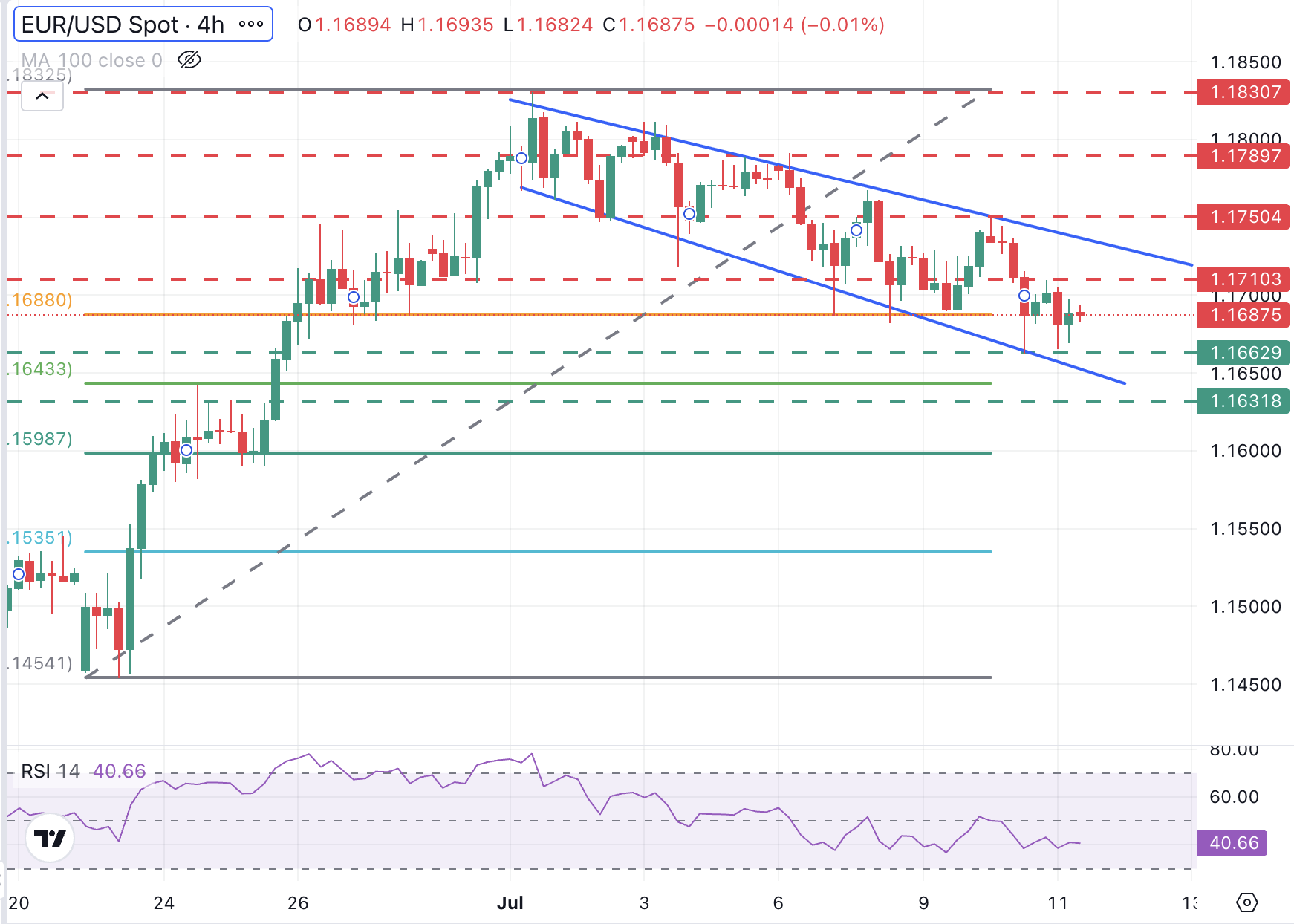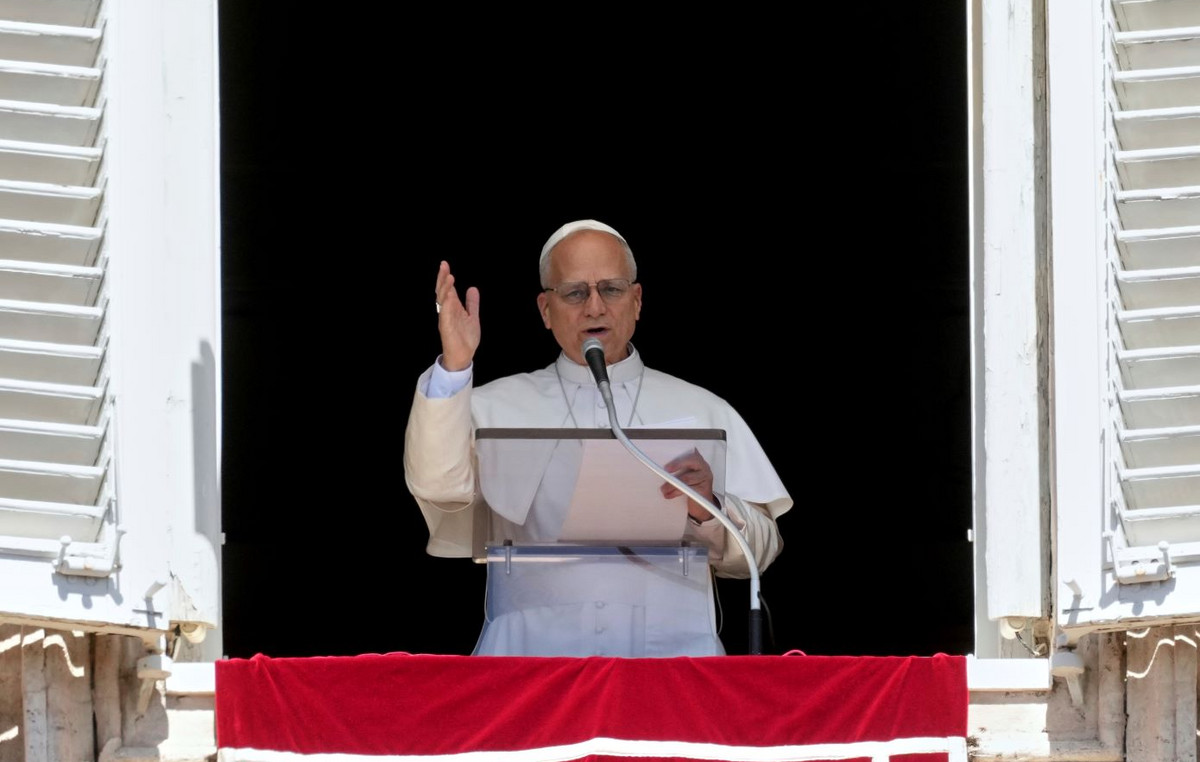- The euro depreciates even more while Trump’s new rates hit the appetite for risk.
- Applications for unemployment subsidy in the US fall unexpectedly, which reduces hope of interest rate cuts by the Fed in the coming months.
- The EUR/USD continues to quote down, with the bassists looking towards the support area of 1,1660.
The Eur/USD He is quoting downwards for the third consecutive day on Friday, with the appetite for the risk contained after the US president, Donald Trump, announced that the European Union (EU) will be included in the next batch of fees of fees and increase the general tariffs for all other countries to 15% or 20% from the previous 10%.
The Euro (EUR) extended its decline against a stronger US dollar (USD) in an Asian risk aversion session and quotes 1,1680 at the time of writing, having reached minimums intradic in 1,1665. The broader image shows the torque in a corrective setback from the long -term maximums achieved on July 1, on the way to close the week with a 0.8%drop.
Trump shake the markets again, this time in a television interview, announcing a new round of rates for a lot of US partners, and that the European Union will be among them this time. These comments generate doubts about the progress of commercial negotiations between both parties, but EU officials remain positive about the possibilities of reaching an agreement before the deadline of August 1.
In the macroeconomic front, US data published on Thursday showed that initial unemployment subsidy applications unexpectedly fell into the first week of June, adding evidence of a resistant labor market and giving an additional impulse to the US dollar.
He calendar Today is quite light, with speeches by the officials of the European Central Bank (ECB) Fabio Panetta and Piero Cipollone, and figures of the current account of Germany during the European morning. In the US, the Wasde agricultural report and the monthly budget declaration will probably not trigger significant volatility.
Euro price today
The lower table shows the percentage of euro change (EUR) compared to the main currencies today. Euro was the strongest currency in front of the Japanese yen.
| USD | EUR | GBP | JPY | CAD | Aud | NZD | CHF | |
|---|---|---|---|---|---|---|---|---|
| USD | 0.22% | 0.26% | 0.44% | 0.32% | 0.06% | 0.33% | 0.06% | |
| EUR | -0.22% | 0.03% | 0.22% | 0.09% | -0.09% | 0.10% | -0.15% | |
| GBP | -0.26% | -0.03% | 0.20% | 0.04% | -0.11% | 0.11% | -0.22% | |
| JPY | -0.44% | -0.22% | -0.20% | -0.13% | -0.40% | -0.15% | -0.41% | |
| CAD | -0.32% | -0.09% | -0.04% | 0.13% | -0.21% | 0.00% | -0.26% | |
| Aud | -0.06% | 0.09% | 0.11% | 0.40% | 0.21% | 0.33% | -0.07% | |
| NZD | -0.33% | -0.10% | -0.11% | 0.15% | 0.00% | -0.33% | -0.31% | |
| CHF | -0.06% | 0.15% | 0.22% | 0.41% | 0.26% | 0.07% | 0.31% |
The heat map shows the percentage changes of the main currencies. The base currency is selected from the left column, while the contribution currency is selected in the upper row. For example, if you choose the euro of the left column and move along the horizontal line to the US dollar, the percentage change shown in the box will represent the EUR (base)/USD (quotation).
What moves the market today: solid employment data provides additional support to the USD
- The US dollar was further recovered on Thursday after the weekly applications for unemployment subsidy in the US fell to a minimum of seven weeks. Initial requests fell at 6,000 to 227,000 compared to the expectations of an increase of 2,000 to 235,000 from the 233,000 applications seen a week earlier.
- Application data reduced the hopes of fed cuts in the coming months and pushed the yields of the US Treasury bonds somewhat higher, leading to the US dollar up with them. The CME Watch tool shows less than 5% possibilities of a rate cut in July and about 65% possibilities of at least 25 basic points (PB) cut in September, lowering 6% and 72%, respectively, a day before.
- Later on Thursday, the governor of the Fed, Christopher Waller, reiterated that the bank’s monetary policy is too restrictive and asked for a rate cut in July, since, he said, inflation by rates will be temporary.
- Likewise, the president of the Fed of San Francisco, Mary Daly, said that the impact of consumer prices will be moderate and predicted two interests of interest rates before the end of the year.
- On the other hand, the president of the Fed of St. Louis, Alberto Musalem, said that it is still too early to assess whether the impact of the rates will be a specific or lasting impulse, highlighting the divergences within the monetary policy committee of the Central Bank of the USA.
- In the Eurozone, on Friday, the official of the European Central Bank, Isabel Schnabel, ruled out more rates cuts unless there is a significant deviation from inflationary trends and observed that the risks for economic growth are balanced.
- Earlier in the day, the consumer price index (CPI) of France confirmed that inflation grew at a rate of 0.4% in June compared to the previous month, while the annual rate was reviewed up to 0.9%, from 0.8% estimated above.
- In Germany, the data published by Destatats on Thursday confirmed preliminary figures that show that consumer inflation was reduced to the 2% year -on -year target in June, while monthly inflation stagnated.
EUR/USD falls even more within a descending channel

EUR/USD Continue to quote in a succession of lower maximum and minimum, in a bassist correction after reaching a peak in 1,1830 on July 1. The price action remains trapped within an expansive wedge pattern, with the support level between the minimum of Thursday, in 1,1660, and the bottom of the channel, in 1,1650, keeping the bassists for now.
The indicators Technicians point down, with the 4 -hour relative force (RSI) index (14) well below level 50 but still far from the overall territory, suggesting that greater depreciation is likely. Below here, the pair could find support in the area of 1,1640-1.1630, where 50% of Fibonacci of recoil of the rebound at the end of June meets the maximum of June 12, 24 and 25.
On the positive side, the maximum intradía, in 1,1710, and the area between the resistance of the channel in 1,1740 and the maximum of Thursday in 1,1750 will probably limit the upward attempts.
Tariffs – Frequently Questions
Although tariffs and taxes generate government income to finance public goods and services, they have several distinctions. Tariffs are paid in advance in the entrance port, while taxes are paid at the time of purchase. Taxes are imposed on individual taxpayers and companies, while tariffs are paid by importers.
There are two schools of thought among economists regarding the use of tariffs. While some argue that tariffs are necessary to protect national industries and address commercial imbalances, others see them as a harmful tool that could potentially increase long -term prices and bring to a harmful commercial war by promoting reciprocal tariffs.
During the election campaign for the presidential elections of November 2024, Donald Trump made it clear that he intends to use tariffs to support the US economy. In 2024, Mexico, China and Canada represented 42% of the total US imports in this period, Mexico stood out as the main exporter with 466.6 billion dollars, according to the US Census Office, therefore, Trump wants to focus on these three nations by imposing tariffs. It also plans to use the income generated through tariffs to reduce personal income taxes.
Source: Fx Street
I am Joshua Winder, a senior-level journalist and editor at World Stock Market. I specialize in covering news related to the stock market and economic trends. With more than 8 years of experience in this field, I have become an expert in financial reporting.







